








生物技术通报 ›› 2024, Vol. 40 ›› Issue (1): 57-71.doi: 10.13560/j.cnki.biotech.bull.1985.2023-0728
陈治民1,2( ), 李翠1, 韦继天1, 李昕然1,2, 刘峄2(
), 李翠1, 韦继天1, 李昕然1,2, 刘峄2( ), 郭强1(
), 郭强1( )
)
收稿日期:2023-07-31
出版日期:2024-01-26
发布日期:2024-02-06
通讯作者:
刘峄,女,硕士,高级实验师,研究方向:观赏植物生产与应用;E-mail: 630923263@qq.com;作者简介:陈治民,男,硕士研究生,研究方向:植物逆境生理与生物育种;E-mail: 1782315561@qq.com;李翠为本文共同第一作者
基金资助:
CHEN Zhi-min1,2( ), LI Cui1, WEI Ji-tian1, LI Xin-ran1,2, LIU Yi2(
), LI Cui1, WEI Ji-tian1, LI Xin-ran1,2, LIU Yi2( ), GUO Qiang1(
), GUO Qiang1( )
)
Received:2023-07-31
Published:2024-01-26
Online:2024-02-06
摘要:
绿原酸(chlorogenic acid, CGA)是一类重要的酚酸类次生代谢物质,广泛存在于植物界中。绿原酸在植物的生长发育、抵御生物与非生物胁迫等方面扮演着重要的角色。另外,它还具有多种生物活性和药理功能,在抗炎、抗菌和降血糖等方面具有重要的应用潜力。然而,植物中绿原酸的含量通常很低,严重制约着其开发利用价值。因此,如何有效提高植物体中绿原酸的含量显得尤为重要。近年来,众多研究者通过基因工程、逆境胁迫及激素处理等手段在提高植株体内绿原酸含量方面取得了重要进展。在此基础上,研究者们对绿原酸的生物合成及其分子机制研究也开启了新的探索,以期为提高植物中体内绿原酸含量提供新的思路。鉴于此,本文对绿原酸的结构与功能、生物合成以及调控等相关研究进展进行了综述,系统分析了绿原酸合成途径中关键限速酶如苯丙氨酸解氨酶(phenylalanine ammonialyase, PAL)、肉桂酸-4-羟化酶(cinnamic acid 4-hydroxylase, C4H)和4-香豆酸-辅酶A连接酶(4-coumarate -CoA ligase, 4CL)等对绿原酸合成的影响;并进一步阐述了MYB、WRKY和bHLH等转录因子调控绿原酸生物合成的作用机制。与此同时,系统归纳总结了生物胁迫、非生物胁迫、植物激素以及光质和光周期等外源因素对植株体内绿原酸含量及其合成调控的影响,并介绍了绿原酸在改善动物健康和人体健康中的作用机理。最后,对绿原酸研究中尚未解决的问题和未来研究方向进行了分析和展望,旨在为绿原酸的合理开发利用以及提高作物抗逆性方面提供有益的参考。
陈治民, 李翠, 韦继天, 李昕然, 刘峄, 郭强. 绿原酸生物合成调控及其应用研究进展[J]. 生物技术通报, 2024, 40(1): 57-71.
CHEN Zhi-min, LI Cui, WEI Ji-tian, LI Xin-ran, LIU Yi, GUO Qiang. Research Progress in the Regulation of Chlorogenic Acid Biosynthesis and Its Application[J]. Biotechnology Bulletin, 2024, 40(1): 57-71.
| 名称Name | 化学结构Chemical structure | 药理活性Pharmacological activity | 参考文献Reference |
|---|---|---|---|
| 3-咖啡酰奎宁酸 3-caffeoylquinic acid | 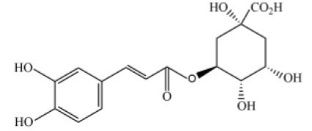 | 抗炎、神经保护、抗自由基、抗肿瘤、调节血糖血脂 | [ |
| 4-咖啡酰奎宁酸 4-caffeoylquinic acid | 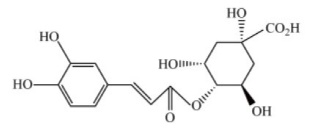 | 抗氧化、抗炎 | [ |
| 5-咖啡酰奎宁酸 5-caffeoylquinic acid |  | 抗氧化、神经保护 | [ |
| 3-阿魏酰奎宁酸 3-feruloylquinic acid | 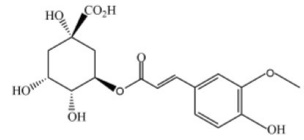 | 抗氧化、抗炎 | [ |
| 4-阿魏酰奎宁酸 4-feruloylquinic acid | 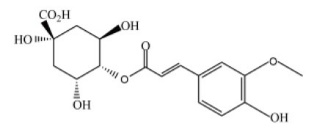 | 抗氧化、抗炎 | [ |
| 5-阿魏酰奎宁酸 5-feruloylquinic acid |  | 抗氧化、抗炎、抗菌、抗糖尿病 | [ |
| 1,3-二咖啡酰奎宁酸 1,3-dicaffeoylquinic acid | 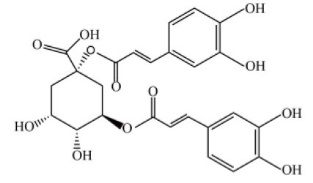 | 抗炎、抗癌 | [ |
| 1,5-二咖啡酰奎宁酸 1,5-dicaffeoylquinic acid | 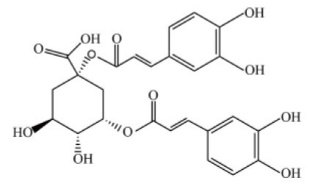 | 抑制α-葡萄糖苷酶、神经保护 | [ |
| 3,4-二咖啡酰奎宁酸 3,4-dicaffeoylquinic acid | 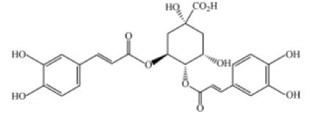 | 抗炎、抗自由基、抗病毒 | [ |
| 3,5-二咖啡酰奎宁酸 3,5-dicaffeoylquinic acid |  | 抗氧化、抗病毒、抗炎 | [ |
| 4,5-二咖啡酰奎宁酸 4,5-dicaffeoylquinic acid | 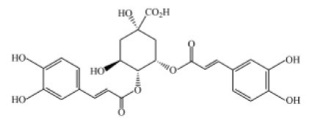 | 抗病毒、抗炎、抗自由基、神经保护 | [ |
| 1,3,5-三咖啡酰奎宁酸 1,3,5-tricaffeoylquinic acid |  | 抗氧化、神经保护 | [ |
| 3,4,5-三咖啡酰奎宁酸 3,4,5-tricaffeoylquinic acid |  | 抗病毒 | [ |
| 绿原酸甲酯 Methyl chlorogenate |  | 抗增殖、清除自由基、抗炎 | [ |
| 绿原酸乙酯 Chlorogenic ethyl ester | 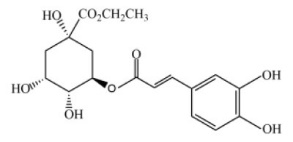 | 抗氧化、抑制黑色素 | [ |
| 绿原酸丁酯 Chlorogenic acid butyl ester |  | 抗氧化、抑制黑色素 | [ |
表1 绿原酸类物质的分子结构与生物活性
Table 1 Molecular structure and bioactivities of chlorogenic acids
| 名称Name | 化学结构Chemical structure | 药理活性Pharmacological activity | 参考文献Reference |
|---|---|---|---|
| 3-咖啡酰奎宁酸 3-caffeoylquinic acid |  | 抗炎、神经保护、抗自由基、抗肿瘤、调节血糖血脂 | [ |
| 4-咖啡酰奎宁酸 4-caffeoylquinic acid |  | 抗氧化、抗炎 | [ |
| 5-咖啡酰奎宁酸 5-caffeoylquinic acid |  | 抗氧化、神经保护 | [ |
| 3-阿魏酰奎宁酸 3-feruloylquinic acid |  | 抗氧化、抗炎 | [ |
| 4-阿魏酰奎宁酸 4-feruloylquinic acid |  | 抗氧化、抗炎 | [ |
| 5-阿魏酰奎宁酸 5-feruloylquinic acid |  | 抗氧化、抗炎、抗菌、抗糖尿病 | [ |
| 1,3-二咖啡酰奎宁酸 1,3-dicaffeoylquinic acid |  | 抗炎、抗癌 | [ |
| 1,5-二咖啡酰奎宁酸 1,5-dicaffeoylquinic acid |  | 抑制α-葡萄糖苷酶、神经保护 | [ |
| 3,4-二咖啡酰奎宁酸 3,4-dicaffeoylquinic acid |  | 抗炎、抗自由基、抗病毒 | [ |
| 3,5-二咖啡酰奎宁酸 3,5-dicaffeoylquinic acid |  | 抗氧化、抗病毒、抗炎 | [ |
| 4,5-二咖啡酰奎宁酸 4,5-dicaffeoylquinic acid |  | 抗病毒、抗炎、抗自由基、神经保护 | [ |
| 1,3,5-三咖啡酰奎宁酸 1,3,5-tricaffeoylquinic acid |  | 抗氧化、神经保护 | [ |
| 3,4,5-三咖啡酰奎宁酸 3,4,5-tricaffeoylquinic acid |  | 抗病毒 | [ |
| 绿原酸甲酯 Methyl chlorogenate |  | 抗增殖、清除自由基、抗炎 | [ |
| 绿原酸乙酯 Chlorogenic ethyl ester |  | 抗氧化、抑制黑色素 | [ |
| 绿原酸丁酯 Chlorogenic acid butyl ester |  | 抗氧化、抑制黑色素 | [ |

图1 绿原酸的生物合成途径 示意图显示了绿原酸的4条合成路径。PAL:苯丙氨酸解氨酶;C4H:肉桂酸-4-羟化酶;4CL:4-香豆酸-辅酶A连接酶;C3H:对-香豆酸3-羟化酶;HCT:莽草酸/奎尼酸羟基肉桂酰转移酶;HQT:羟基肉桂酰辅酶A奎尼羟基肉桂转移酶;HCGQT:羟基肉桂酰基D-葡萄糖:奎宁酸羟基肉桂酰基转移酶。绿原酸合成路线的表述参见文中解释
Fig. 1 Biosynthesis pathway of chlorogenic acid Schematic cartoon displays four synthetic pathways of chlorogenic acid. PAL: Phenylalanine ammonialyase. C4H: Cinnamic acid 4-hydroxylase. 4CL: 4-coumarate -CoA ligase. C3H: ρ-coumaroylester 3-hydroxylases. HCT: Shikimic acid/quinic acid hydroxycinnamoyl transferase. HQT: Hydroxycinnamoyl-CoA: quinate hydroxycinnamoyl transferase. HCGQT: Hydroxyl cinnamoyl D-glucose: quinate hydroxycinnamoyl transferase. The expression of the synthetic route of chlorogenic acid is explained in the article
| [1] |
Shamanthaka SMC, Narasinga RMS. Binding of chlorogenic acid by the isolated polyphenol-free 11 S protein of sunflower(Helianthus annuus)seed[J]. J Agric Food Chem, 1990, 38(12): 2103-2110.
doi: 10.1021/jf00102a001 URL |
| [2] |
Lallemand LA, Zubieta C, Lee SG, et al. A structural basis for the biosynthesis of the major chlorogenic acids found in coffee[J]. Plant Physiol, 2012, 160(1): 249-260.
doi: 10.1104/pp.112.202051 pmid: 22822210 |
| [3] |
Santana-Gálvez J, Cisneros-Zevallos L, Jacobo-Velázquez DA. Chlorogenic acid: recent advances on its dual role as a food additive and a nutraceutical against metabolic syndrome[J]. Molecules, 2017, 22(3): 358.
doi: 10.3390/molecules22030358 URL |
| [4] |
Naveed M, Hejazi V, Abbas M, et al. Chlorogenic acid(CGA): a pharmacological review and call for further research[J]. Biomed Pharmacother, 2018, 97: 67-74.
doi: 10.1016/j.biopha.2017.10.064 URL |
| [5] |
Liberato JL, Rosa MN, Miranda MCR, et al. Neuroprotective properties of chlorogenic acid and 4, 5-caffeoylquinic acid from Brazilian arnica(Lychnophora ericoides)after acute retinal ischemia[J]. Planta Med, 2023, 89(2): 183-193.
doi: 10.1055/a-1903-2387 URL |
| [6] | Mishchenko O, Kyrychenko I, Gontova T, et al. Research on the phenolic profile, antiradical and anti-inflammatory activity of a thick hydroalcoholic feverfew(Tanacetum parthenium L.) herb extract[J]. ScienceRise Pharm Sci, 2022, 5(39): 91-99. |
| [7] |
Wang L, Pan XQ, Jiang LS, et al. The biological activity mechanism of chlorogenic acid and its applications in food industry: a review[J]. Front Nutr, 2022, 9: 943911.
doi: 10.3389/fnut.2022.943911 URL |
| [8] | 曹凡, 陈琳, 宋忠兴, 等. 金茵利胆胶囊的高效液相色谱指纹图谱及其抗氧化作用的灰色关联分析[J]. 中南药学, 2022, 20(3): 574-579. |
| Cao F, Chen L, Song ZX, et al. Grey correlation analysis of HPLC fingerprint of Jinyin Lidan capsules and their antioxidant in vitro[J]. Cent South Pharm, 2022, 20(3): 574-579. | |
| [9] | Li HY, Xiao MF, Pan X, et al. Comparative polypharmacokinetics of nine anti-inflammatory components of Jinyinhua(Lonicerae Japonicae Flos)and Shanyinhua(Lonicerae flos)in mice with p-xylene-induced ear edema[J]. Digit Chin Med, 2023, 6(1): 73-85. |
| [10] |
Shamilov AA, Olennikov DN, Pozdnyakov DI, et al. Caucasian blueberry: comparative study of phenolic compounds and neuroprotective and antioxidant potential of Vaccinium myrtillus and Vaccinium arctostaphylos leaves[J]. Life, 2022, 12(12): 2079.
doi: 10.3390/life12122079 URL |
| [11] |
Udomwasinakun N, Saha S, Mulet-Cabero AI, et al. Assessment of polyphenols bioaccessibility, stability, and antioxidant activity of white mugwort(Artemisia lactiflora wall.) during static in vitro gastrointestinal digestion[J]. Foods, 2023, 12(5): 949.
doi: 10.3390/foods12050949 URL |
| [12] |
Ao XL, Yan JL, Liu SL, et al. Extraction, isolation and identification of four phenolic compounds from Pleioblastus amarus shoots and their antioxidant and anti-inflammatory properties in vitro[J]. Food Chem, 2022, 374: 131743.
doi: 10.1016/j.foodchem.2021.131743 URL |
| [13] |
Pereira-Caro G, Ordóñez-Díaz JL, de Santiago E, et al. Antioxidant activity and bio-accessibility of polyphenols in black carrot(Daucus carota L. ssp. sativus var. atrorubens alef.)and two derived products during simulated gastrointestinal digestion and colonic fermentation[J]. Foods, 2021, 10(2): 457.
doi: 10.3390/foods10020457 URL |
| [14] |
Oliveira ALS, Carvalho MJ, Oliveira DL, et al. Sugarcane straw polyphenols as potential food and nutraceutical ingredient[J]. Foods, 2022, 11(24): 4025.
doi: 10.3390/foods11244025 URL |
| [15] | 曹凡, 宋忠兴, 陈琳, 等. 金茵利胆胶囊的体外抗炎活性评价及其谱效关系[J]. 海军军医大学学报, 2023, 44(4): 418-426. |
| Cao F, Song ZX, Chen L, et al. Evaluation for in vitro anti-inflammatory activity of Jinyin Lidan capsule and its spectrum-effect relation[J]. Acad J Nav Med Univ, 2023, 44(4): 418-426. | |
| [16] |
Zhou YH, Fu X, Guan YQ, et al. 1, 3-Dicaffeoylquinic acid targeting 14-3-3 tau suppresses human breast cancer cell proliferation and metastasis through IL6/JAK2/PI3K pathway[J]. Biochem Pharmacol, 2020, 172: 113752.
doi: 10.1016/j.bcp.2019.113752 URL |
| [17] |
Etemadi-Tajbakhsh N, Faramarzi MA, Delnavazi MR. 1, 5-dicaffeoylquinic acid, an α-glucosidase inhibitor from the root of Dorema ammoniacum D. don[J]. Res Pharm Sci, 2020, 15(5): 429-436.
doi: 10.4103/1735-5362.297845 pmid: 33628284 |
| [18] | Xiao HB, Cao X, Wang L, et al. 1, 5-dicaffeoylquinic acid protects primary neurons from amyloid β 1-42-induced apoptosis via PI3K/Akt signaling pathway[J]. Chin Med J, 2011, 124(17): 2628-2635. |
| [19] |
Wang F, Kong BLH, Tang YS, et al. Bioassay guided isolation of caffeoylquinic acids from the leaves of Ilex pubescens Hook. et Arn. and investigation of their anti-influenza mechanism[J]. J Ethnopharmacol, 2023, 309: 116322.
doi: 10.1016/j.jep.2023.116322 URL |
| [20] |
Park J, Kim Y, Lee C, et al. 3, 5-Dicaffeoylquinic acid attenuates microglial activation-mediated inflammatory pain by enhancing autophagy through the suppression of MCP3/JAK2/STAT3 signaling[J]. Biomed Pharmacother, 2022, 153: 113549.
doi: 10.1016/j.biopha.2022.113549 URL |
| [21] |
Wan LX, Zhang JF, Zhen YQ, et al. Isolation, structure elucidation, semi-synthesis, and structural modification of C19-diterpenoid alkaloids from Aconitum apetalum and their neuroprotective activities[J]. J Nat Prod, 2021, 84(4): 1067-1077.
doi: 10.1021/acs.jnatprod.0c01111 URL |
| [22] |
Yang Y, Ding YF, Gao H, et al. TCQA, A natural caffeoylquinic acid derivative attenuates H2O2-induced neuronal apoptosis by suppressing phosphorylation of MAPKs signaling pathway[J]. Planta Med, 2022, 88(13): 1132-1140.
doi: 10.1055/a-1683-6361 URL |
| [23] |
Pang YL, Lin YS, Wang XQ, et al. Inhibition of abnormally activated HIF-1α-GLUT1/3-glycolysis pathway enhances the sensitivity of hepatocellular carcinoma to 5-caffeoylquinic acid and its derivatives[J]. Eur J Pharmacol, 2022, 920: 174844.
doi: 10.1016/j.ejphar.2022.174844 URL |
| [24] |
Yin J, Heo JH, Hwang YJ, et al. Inhibitory activities of phenolic compounds isolated from Adina rubella leaves against 5α-reductase associated with benign prostatic hypertrophy[J]. Molecules, 2016, 21(7): 887.
doi: 10.3390/molecules21070887 URL |
| [25] | 段世廉, 唐生安, 秦楠, 等. 金鸡脚化学成分及其抗氧化活性[J]. 中国中药杂志, 2012, 37(10): 1402-1407. |
| Duan SL, Tang SA, Qin N, et al. Chemical constituents of Phymatopteris hastate and their antioxidant activity[J]. China J Chin Mater Med, 2012, 37(10): 1402-1407. | |
| [26] |
Akihisa T, Kawashima K, Orido M, et al. Antioxidative and melanogenesis-inhibitory activities of caffeoylquinic acids and other compounds from moxa[J]. Chem Biodivers, 2013, 10(3): 313-327.
doi: 10.1002/cbdv.201200357 pmid: 23495149 |
| [27] |
Kai K, Wang R, Bi WL, et al. Chlorogenic acid induces ROS-dependent apoptosis in Fusarium fujikuroi and decreases the postharvest rot of cherry tomato[J]. World J Microbiol Biotechnol, 2021, 37(6): 93.
doi: 10.1007/s11274-021-03062-x |
| [28] | 张豫丹, 马晓寒, 李俊领, 等. 绿原酸对烟草疫霉的抑制作用及对烟草黑胫病的防治效果研究[J]. 作物杂志, 2022(2): 230-236. |
| Zhang YD, Ma XH, Li JL, et al. Inhibitory effect of chlorogenic acid on Phytophthora nicotiana and its control effect on tobacco black shank disease[J]. Crops, 2022(2): 230-236. | |
| [29] | 刘晓霞. 三种植物次生物质对美国白蛾生长发育和解毒能力的影响[D]. 东北林业大学, 2020. |
| Liu XX. Effects of three plant secondary substances on the growth and detoxification ability of Hyphantria cunea[D]. Northeast Forestry University, 2020. | |
| [30] | 潘忠玉, 莫夏娜, 孟香, 等. 绿原酸对美国白蛾幼虫生长发育和解毒相关蛋白活性的影响[J]. 昆虫学报, 2020, 63(9): 1081-1090. |
| Pan ZY, Mo XN, Meng X, et al. Effects of chlorogenic acid on the growth and development and detoxification-related(Lepidoptera: Arctiidae)larvae[J]. Acta Entomol Sin, 2020, 63(9): 1081-1090. | |
| [31] |
Moyo B, Tavengwa NT, Madala NE. Diverse chemical modifications of the chlorogenic acid composition of Viscum combreticola Engl.: a premise for the state of readiness against excessive sunlight exposure[J]. J Photochem Photobiol B, 2022, 233: 112501.
doi: 10.1016/j.jphotobiol.2022.112501 URL |
| [32] |
Yan K, Cui JX, Zhi YB, et al. Deciphering salt tolerance in tetraploid honeysuckle(Lonicera japonica Thunb.) from ion homeostasis, water balance and antioxidant defense[J]. Plant Physiology and Biochemistry, 2023, 195: 266-274
doi: 10.1016/j.plaphy.2023.01.013 URL |
| [33] | 辛邵南. 滩涂适生菊芋绿原酸合成途径相关基因响应高温与盐胁迫的机理分析[D]. 南京农业大学, 2019. |
| Xin SN. Analysis of mechanism of relative gene responses of high temperature and salt stresses to chlorogenic acid synthesis pathway in jerusalem artichoke growth in tidal flats[D]. Nanjing Agricultural University, 2019. | |
| [34] | 马志桃. 绿原酸对草莓采后灰霉病的抑制作用机理研究[D]. 合肥: 合肥工业大学, 2022. |
| Ma ZT. Inhibitory mechanism of chlorogenic acid on postharst Botrytis cinerea of strawberry[D]. Hefei: Hefei University of Technology, 2022. | |
| [35] |
Jin XX, Su MY, Liang YX, et al. Effects of chlorogenic acid on growth, metabolism, antioxidation, immunity, and intestinal flora of crucian carp(Carassius auratus)[J]. Front Microbiol, 2023, 13: 1084500.
doi: 10.3389/fmicb.2022.1084500 URL |
| [36] |
Tan C, Xu QD, Chen N, et al. Cross-linking modifications of different phenolic compounds on myofibrillar protein of common carp[J]. Food Bioprocess Technol, 2023, 16(3): 627-638.
doi: 10.1007/s11947-022-02958-2 |
| [37] |
Liu YH, Zhang Y, Bai DY, et al. Dietary supplementation with chlorogenic acid enhances antioxidant capacity, which promotes growth, jejunum barrier function, and cecum microbiota in broilers under high stocking density stress[J]. Animals, 2023, 13(2): 303.
doi: 10.3390/ani13020303 URL |
| [38] |
Wang WL, Wen CY, Guo QP, et al. Dietary supplementation with chlorogenic acid derived from Lonicera macranthoides hand-mazz improves meat quality and muscle fiber characteristics of finishing pigs via enhancement of antioxidant capacity[J]. Front Physiol, 2021, 12: 650084.
doi: 10.3389/fphys.2021.650084 URL |
| [39] |
Cheng J, Sun N, Zhao X, et al. In vitro screening for compounds derived from traditional Chinese medicines with antiviral activities against porcine reproductive and respiratory syndrome virus[J]. J Microbiol Biotechnol, 2013, 23(8): 1076-1083.
doi: 10.4014/jmb URL |
| [40] |
Abaidullah M, Peng SW, Song X, et al. Chlorogenic acid is a positive regulator of MDA5, TLR7 and NF-κB signaling pathways mediated antiviral responses against Gammacoronavirus infection[J]. Int Immunopharmacol, 2021, 96: 107671.
doi: 10.1016/j.intimp.2021.107671 URL |
| [41] |
Gao RF, Yang HD, Jing SF, et al. Protective effect of chlorogenic acid on lipopolysaccharide-induced inflammatory response in dairy mammary epithelial cells[J]. Microb Pathog, 2018, 124: 178-182.
doi: 10.1016/j.micpath.2018.07.030 URL |
| [42] | 宋丹萍, 张珊, 宋志刚, 等. 绿原酸及其异构体功能比较、结构修饰及在动物上应用的研究进展[J]. 中国畜牧杂志, 2023, 59(1): 10-19. |
| Song DP, Zhang S, Song ZG, et al. Research progress on the structural and functional comparison, structural modification of chlorogenic acid and its isomers and application in animals[J]. Chin J Anim Sci, 2023, 59(1): 10-19. | |
| [43] |
Park I, Ochiai R, Ogata H, et al. Effects of subacute ingestion of chlorogenic acids on sleep architecture and energy metabolism through activity of the autonomic nervous system: a randomised, placebo-controlled, double-blinded cross-over trial[J]. Br J Nutr, 2017, 117(7): 979-984.
doi: 10.1017/S0007114517000587 URL |
| [44] | Kato M, Ochiai R, Kozuma K, et al. Effect of chlorogenic acid intake on cognitive function in the elderly: a pilot study[J]. Evid Based Complement Alternat Med, 2018, 2018: 8608497. |
| [45] | 尹泽群. 绿原酸抗认知障碍功能与机理研究[D]. 合肥: 合肥工业大学, 2022. |
| Yin ZQ. The investigation on the anti-cognitive impairment effect and the mechanisms by chlorogenic acid[D]. Hefei: Hefei University of Technology, 2022. | |
| [46] | Song L, Yang H, Liang D, et al. A chlorogenic acid-loaded hyaluronic acid-based hydrogel facilitates anti-inflammatory and pro-healing effects for diabetic wounds[J]. J Drug Deliv Sci Technol, 2022, 70: 103232. |
| [47] |
Gupta A, Atanasov AG, Li YT, et al. Chlorogenic acid for cancer prevention and therapy: current status on efficacy and mechanisms of action[J]. Pharmacol Res, 2022, 186: 106505.
doi: 10.1016/j.phrs.2022.106505 URL |
| [48] | 王庆华, 杜婷婷, 张智慧, 等. 绿原酸的药理作用及机制研究进展[J]. 药学学报, 2020, 55(10): 2273-2280. |
| Wang QH, Du TT, Zhang ZH, et al. Advances in research on the pharmacological effects and mechanism of action of chlorogenic acid[J]. Acta Pharm Sin, 2020, 55(10): 2273-2280. | |
| [49] |
Valiñas MA, Lanteri ML ten Have A, et al. Chlorogenic acid biosynthesis appears linked with suberin production in potato Tuber(Solanum tuberosum)[J]. J Agric Food Chem, 2015, 63(19): 4902-4913.
doi: 10.1021/jf505777p URL |
| [50] |
Tang N, Cao ZY, Yang C, et al. A R2R3-MYB transcriptional activator LmMYB15 regulates chlorogenic acid biosynthesis and phenylpropanoid metabolism in Lonicera macranthoides[J]. Plant Sci, 2021, 308: 110924.
doi: 10.1016/j.plantsci.2021.110924 URL |
| [51] |
Niggeweg R, Michael AJ, Martin C. Engineering plants with increased levels of the antioxidant chlorogenic acid[J]. Nat Biotechnol, 2004, 22(6): 746-754.
doi: 10.1038/nbt966 pmid: 15107863 |
| [52] |
Chen HC, Li QZ, Shuford CM, et al. Membrane protein complexes catalyze both 4- and 3-hydroxylation of cinnamic acid derivatives in monolignol biosynthesis[J]. Proc Natl Acad Sci USA, 2011, 108(52): 21253-21258.
doi: 10.1073/pnas.1116416109 URL |
| [53] |
Clé C, Hill LM, Niggeweg R, et al. Modulation of chlorogenic acid biosynthesis in Solanum lycopersicum; consequences for phenolic accumulation and UV-tolerance[J]. Phytochemistry, 2008, 69(11): 2149-2156.
doi: 10.1016/j.phytochem.2008.04.024 URL |
| [54] |
Zhao ZC, Gao AP, Luo RX, et al. The different deletion mutation in the phenylalanine ammonia-lyase(PAL)gene affects the peel color of mango(Mangifera indica L.)[J]. Genet Resour Crop Evol, 2022, 69(7): 2301-2306.
doi: 10.1007/s10722-022-01393-8 |
| [55] |
Yu Y, Wang YJ, Yu Y, et al. Overexpression of IbPAL1 promotes chlorogenic acid biosynthesis in sweetpotato[J]. Crop J, 2021, 9(1): 204-215.
doi: 10.1016/j.cj.2020.06.003 URL |
| [56] |
Zhang CC, Yao XH, Ren HD, et al. Genome-wide identification and characterization of the phenylalanine ammonia-lyase gene family in pecan(Carya illinoinensis)[J]. Sci Hortic, 2022, 295: 110800.
doi: 10.1016/j.scienta.2021.110800 URL |
| [57] |
Zhang BX, Lewis KM, Abril A, et al. Structure and function of the cytochrome P450 monooxygenase cinnamate 4-hydroxylase from Sorghum bicolor[J]. Plant Physiol, 2020, 183(3): 957-973.
doi: 10.1104/pp.20.00406 URL |
| [58] |
Cheng SY, Yan JP, Meng XX, et al. Characterization and expression patterns of a cinnamate-4-hydroxylase gene involved in lignin biosynthesis and in response to various stresses and hormonal treatments in Ginkgo biloba[J]. Acta Physiol Plant, 2017, 40(1): 7.
doi: 10.1007/s11738-017-2585-4 |
| [59] |
Karlson CKS, Mohd Noor SN, Khalid N, et al. CRISPRi-mediated down-regulation of the cinnamate-4-hydroxylase(C4H)gene enhances the flavonoid biosynthesis in Nicotiana tabacum[J]. Biology, 2022, 11(8): 1127.
doi: 10.3390/biology11081127 URL |
| [60] |
Alariqi M, Ramadan M, Wang QQ, et al. Cotton 4-coumarate-CoA ligase 3 enhanced plant resistance to Verticillium dahliae by promoting jasmonic acid signaling-mediated vascular lignification and metabolic flux[J]. Plant J, 2023, 115(1): 190-204.
doi: 10.1111/tpj.v115.1 URL |
| [61] |
Li MZ, Guo LL, Wang YR, et al. Molecular and biochemical characterization of two 4-coumarate: CoA ligase genes in tea plant(Camellia sinensis)[J]. Plant Mol Biol, 2022, 109(4/5): 579-593.
doi: 10.1007/s11103-022-01269-6 |
| [62] |
Wang YY, Guo LH, Zhao YJ, et al. Systematic analysis and expression profiles of the 4-coumarate: CoA ligase(4CL)gene family in pomegranate(Punica granatum L.)[J]. Int J Mol Sci, 2022, 23(7): 3509.
doi: 10.3390/ijms23073509 URL |
| [63] |
Ma ZH, Nan XT, Li WF, et al. Comprehensive genomic identification and expression analysis 4CL gene family in apple[J]. Gene, 2023, 858: 147197.
doi: 10.1016/j.gene.2023.147197 URL |
| [64] |
Yang YH, Zhang ZY, Li RF, et al. RgC3H involves in the biosynthesis of allelopathic phenolic acids and alters their release amount in Rehmannia glutinosa roots[J]. Plants, 2020, 9(5): 567.
doi: 10.3390/plants9050567 URL |
| [65] | 朱冉冉, 吉雪花, 张中荣, 等. 辣椒C3H转录因子家族的生物信息学分析[J]. 分子植物育种, 2020, 18(6): 1784-1791. |
| Zhu RR, Ji XH, Zhang ZR, et al. Bioinformatics analysis of Capsicum C3H transcription factor family[J]. Mol Plant Breed, 2020, 18(6): 1784-1791. | |
| [66] | 李洋, 唐雪冰, 李晓峰, 等. NtC3H基因对烟草类黄酮及绿原酸合成的影响[J]. 中国烟草科学, 2016, 37(1): 8-13. |
| Li Y, Tang XB, Li XF, et al. The influence of NtC3H on the synthesis of flavonoids and chlorogenic acid in tobacco[J]. Chin Tob Sci, 2016, 37(1): 8-13. | |
| [67] |
Sun F, Ahmad N, Jin LB, et al. Genome-wide investigation of Hydroxycinnamoyl CoA: Shikimate Hydroxycinnamoyl Transferase(HCT)gene family in Carthamus tinctorius L[J]. Not Bot Horti Agrobo, 2021, 49(3): 12489.
doi: 10.15835/nbha49312489 URL |
| [68] |
Chao N, Qi Q, Li S, et al. Characterization and functional analysis of the Hydroxycinnamoyl-CoA: shikimate hydroxycinnamoyl transferase(HCT)gene family in poplar[J]. PeerJ, 2021, 9: e10741.
doi: 10.7717/peerj.10741 URL |
| [69] |
Hoffmann L, Maury S, Martz F, et al. Purification, cloning, and properties of an acyltransferase controlling shikimate and quinate ester intermediates in phenylpropanoid metabolism[J]. J Biol Chem, 2003, 278(1): 95-103.
doi: 10.1074/jbc.M209362200 pmid: 12381722 |
| [70] | 李洋, 李明, 岳玮, 等. 烟草NtHCT基因对次生代谢物质绿原酸和类黄酮合成的影响[J]. 中国烟草学报, 2015, 21(6): 127-131. |
| Li Y, Li M, Yue W, et al. Effect of NtHCT gene on synthesis of chlorogenic acid and flavonoid in tobacco[J]. Acta Tabacaria Sin, 2015, 21(6): 127-131. | |
| [71] |
Cardenas CL, Costa MA, Laskar DD, et al. RNAi modulation of chlorogenic acid and lignin deposition in Nicotiana tabacum and insufficient compensatory metabolic cross-talk[J]. J Nat Prod, 2021, 84(3): 694-706.
doi: 10.1021/acs.jnatprod.1c00054 pmid: 33687206 |
| [72] |
Serrani-Yarce JC, Escamilla-Trevino L, Barros J, et al. Targeting hydroxycinnamoyl CoA: shikimate hydroxycinnamoyl transferase for lignin modification in Brachypodium distachyon[J]. Biotechnol Biofuels, 2021, 14(1): 50.
doi: 10.1186/s13068-021-01905-1 pmid: 33640016 |
| [73] | Mathatha K, Mwaba I, Mathomu LM, et al. SMRT sequencing and characterization of putative hydroxycinnamoyl-CoA: Quinate/shikimate acid hydroxycinnamoyl transferase(HQT/HCT)genes responsible for biosynthesis of structurally diverse chlorogenic acids in Bidens pilosa[J]. S Afr N J Bot, 2023, 152: 92-105. |
| [74] | Moglia A, Acquadro A, Eljounaidi K, et al. Genome-wide identification of BAHD acyltransferases and in vivo characterization of HQT-like enzymes involved in caffeoylquinic acid synthesis in globe artichoke[J]. Front Plant Sci, 2016, 7: 1424. |
| [75] |
Li YQ, Kong DX, Bai M, et al. Correlation of the temporal and spatial expression patterns of HQT with the biosynthesis and accumulation of chlorogenic acid in Lonicera japonica flowers[J]. Hortic Res, 2019, 6: 73.
doi: 10.1038/s41438-019-0154-2 |
| [76] |
Liu Q, Liu Y, Xu YC, et al. Overexpression of and RNA interference with hydroxycinnamoyl-CoA quinate hydroxycinnamoyl transferase affect the chlorogenic acid metabolic pathway and enhance salt tolerance in Taraxacum antungense Kitag[J]. Phytochem Lett, 2018, 28: 116-123.
doi: 10.1016/j.phytol.2018.10.003 URL |
| [77] |
Yamada Y, Sato F. Transcription factors in alkaloid engineering[J]. Biomolecules, 2021, 11(11): 1719.
doi: 10.3390/biom11111719 URL |
| [78] |
Xiao QQ, Li ZQ, Qu MM, et al. LjaFGD: Lonicera japonica functional genomics database[J]. J Integr Plant Biol, 2021, 63(8): 1422-1436.
doi: 10.1111/jipb.v63.8 URL |
| [79] |
Ji NN, Wang J, Li YF, et al. Involvement of PpWRKY70 in the methyl jasmonate primed disease resistance against Rhizopus stolonifer of peaches via activating phenylpropanoid pathway[J]. Postharvest Biol Technol, 2021, 174: 111466.
doi: 10.1016/j.postharvbio.2021.111466 URL |
| [80] | Liu Q, Zhou W, Ruan QY, et al. Overexpression of TaWRKY14 transcription factor enhances accumulation of chlorogenic acid in Taraxacum antungense Kitag and increases its resistance to powdery mildew[J]. Plant Cell Tissue Organ Cult PCTOC, 2020, 143(3): 665-679. |
| [81] |
Zhang J, Yang Y, Zheng KJ, et al. Genome-wide association studies and expression-based quantitative trait loci analyses reveal roles of HCT2 in caffeoylquinic acid biosynthesis and its regulation by defense-responsive transcription factors in Populus[J]. New Phytol, 2018, 220(2): 502-516.
doi: 10.1111/nph.15297 pmid: 29992670 |
| [82] | 王中, 赵利杰, 刘萍萍, 等. 烟草NtMYB59基因克隆及过表达对绿原酸含量的影响[J]. 烟草科技, 2021, 54(5): 1-7. |
| Wang Z, Zhao LJ, Liu PP, et al. Cloning and over-expressing tobacco NtMYB59 gene and the effects on chlorogenic acid content[J]. Tob Sci Technol, 2021, 54(5): 1-7. | |
| [83] | 代丽丽. 转AtMYB12基因提高马铃薯中绿原酸含量的研究[D]. 泰安: 山东农业大学, 2013. |
| Dai LL. Research of chlorogenic acid-improved transgenic potato with AtMYB12[D]. Tai'an: Shandong Agricultural University, 2013. | |
| [84] |
Ma DW, Reichelt M, Yoshida K, et al. Two R2R3-MYB proteins are broad repressors of flavonoid and phenylpropanoid metabolism in poplar[J]. Plant J, 2018, 96(5): 949-965.
doi: 10.1111/tpj.2018.96.issue-5 URL |
| [85] |
Li MZ, Li YZ, Guo LL, et al. Functional characterization of tea(Camellia sinensis)MYB4a transcription factor using an integrative approach[J]. Front Plant Sci, 2017, 8: 943.
doi: 10.3389/fpls.2017.00943 URL |
| [86] | Docimo T, Francese G, Ruggiero A, et al. Phenylpropanoids accumulation in eggplant fruit: characterization of biosynthetic genes and regulation by a MYB transcription factor[J]. Front Plant Sci, 2016, 6: 1233. |
| [87] | 陈帅. 烟草类黄酮代谢途径中关键酶CHS基因与R2R3 MYB类转录抑制因子功能研究[D]. 雅安: 四川农业大学, 2017. |
| Chen S. Functional analysis of CHS genes and R2R3 MYB repressors related to flavonoid biosynthesis pathway in Nicotiana tabacum[D]. Ya'an: Sichuan Agricultural University, 2017. | |
| [88] |
Liu Q, Li L, Cheng HT, et al. The basic helix-loop-helix transcription factor TabHLH1 increases chlorogenic acid and luteolin biosynthesis in Taraxacum antungense Kitag[J]. Hortic Res, 2021, 8(1): 195.
doi: 10.1038/s41438-021-00630-y |
| [89] |
Wang Z, Yang JC, Gao Q, et al. The transcription factor NtERF13a enhances abiotic stress tolerance and phenylpropanoid compounds biosynthesis in tobacco[J]. Plant Sci, 2023, 334: 111772.
doi: 10.1016/j.plantsci.2023.111772 URL |
| [90] |
Zha LP, Liu S, Liu J, et al. DNA methylation influences chlorogenic acid biosynthesis in Lonicera japonica by mediating LjbZIP8 to regulate phenylalanine ammonia-lyase 2 expression[J]. Front Plant Sci, 2017, 8: 1178.
doi: 10.3389/fpls.2017.01178 URL |
| [91] |
Chen YC, Xu N, Du LH, et al. Light plays a critical role in the accumulation of chlorogenic acid in Lonicera macranthoides Hand.-Mazz[J]. Plant Physiol Biochem, 2023, 196: 793-806.
doi: 10.1016/j.plaphy.2023.02.016 URL |
| [92] |
Negi S, Bhakta S, Ganapathi TR, et al. MusaNAC29-like transcription factor improves stress tolerance through modulation of phytohormone content and expression of stress responsive genes[J]. Plant Sci, 2023, 326: 111507.
doi: 10.1016/j.plantsci.2022.111507 URL |
| [93] | Atak A, Göksel Z, Söylemezoğlu G. Changes in post-disease amounts of some phenolic compounds in different Vitis species[J]. Acta Hortic, 2020(1276): 31-40. |
| [94] | 柴楠. 索邦百合响应椭圆葡萄孢(Botrytis elliptica)侵染的转录和代谢组学分析及抗病关键基因的筛选[D]. 重庆: 西南大学, 2021. |
| Chai N. Trascriptomic and Metabolic profiling of Lilium infected with Botrytis elliptica and screening of key genes for resistant diseases[D]. Chongqing: Southwest University, 2021. | |
| [95] |
Rashad Y, Aseel D, Hammad S, et al. Rhizophagus irregularis and Rhizoctonia solani differentially elicit systemic transcriptional expression of polyphenol biosynthetic pathways genes in sunflower[J]. Biomolecules, 2020, 10(3): 379.
doi: 10.3390/biom10030379 URL |
| [96] |
Aseel DG, Rashad YM, Hammad SM. Arbuscular mycorrhizal fungi trigger transcriptional expression of flavonoid and chlorogenic acid biosynthetic pathways genes in tomato against tomato mosaic virus[J]. Sci Rep, 2019, 9(1): 9692.
doi: 10.1038/s41598-019-46281-x pmid: 31273308 |
| [97] | Caliskan O, Radusiene J, Temizel KE, et al. The effects of salt and drought stress on phenolic accumulation in greenhouse-grown Hypericum pruinatum[J]. Ital J Agronomy, 2017, 12(3): 271-275. |
| [98] | Eray N, Dalar A, Turker M. The effects of abiotic stressors and signal molecules on phenolic composition and antioxidant activities of in vitro regenerated Hypericum perforatum(St. John's Wort)[J]. S Afr N J Bot, 2020, 133: 253-263. |
| [99] |
Sun CH, Yang CY, Tzen JTC. Molecular identification and characterization of hydroxycinnamoyl transferase in tea plants(Camellia sinensis L.)[J]. Int J Mol Sci, 2018, 19(12): 3938.
doi: 10.3390/ijms19123938 URL |
| [100] |
Zha Y, Zhao B, Qiu JR, et al. Integrated transcriptomic and metabolomic analyses of pak choi[Brassica pekinensis(Lour.) Rupr]response to combined stress of acid rain and cadmium-containing atmospheric fine particulate matter[J]. Front Environ Sci, 2022, 10: 1020308.
doi: 10.3389/fenvs.2022.1020308 URL |
| [101] |
Kamalizadeh M, Bihamta M, Zarei A. Drought stress and TiO2 nanoparticles affect the composition of different active compounds in the Moldavian dragonhead plant[J]. Acta Physiol Plant, 2019, 41(2): 21.
doi: 10.1007/s11738-019-2814-0 |
| [102] |
Kısa D, Elmastaş M, Öztürk L, et al. Responses of the phenolic compounds of Zea mays under heavy metal stress[J]. Appl Biol Chem, 2016, 59(6): 813-820.
doi: 10.1007/s13765-016-0229-9 URL |
| [103] | Kisa D, Kayir ÖN, Saglam S, et al. Changes of phenolic compounds in tomato associated with the heavy metal stress[J]. International Journal of Natural and Applied Sciences, 2019, 2(1): 35-43. |
| [104] |
Yu Y, Zhang Q, Liu S, et al. Effects of exogenous phytohormones on chlorogenic acid accumulation and pathway-associated gene expressions in sweetpotato stem tips[J]. Plant Physiol Biochem, 2021, 164: 21-26.
doi: 10.1016/j.plaphy.2021.04.014 URL |
| [105] |
Tosetti R, Elmi F, Pradas I, et al. Continuous exposure to ethylene differentially affects senescence in receptacle and achene tissues in strawberry fruit[J]. Front Plant Sci, 2020, 11: 174.
doi: 10.3389/fpls.2020.00174 pmid: 32226433 |
| [106] |
Li SC, Xiao LH, Chen M, et al. The involvement of the phenylpropanoid and jasmonate pathways in methyl jasmonate-induced soft rot resistance in kiwifruit(Actinidia chinensis)[J]. Front Plant Sci, 2022, 13: 1097733.
doi: 10.3389/fpls.2022.1097733 URL |
| [107] | Yadav P, Kaur R, Kohli SK, et al. Castasterone assisted accumulation of polyphenols and antioxidant to increase tolerance of B. juncea plants towards copper toxicity[J]. Cogent Food Agric, 2016, 2(1): 1276821. |
| [108] |
Jiao XY, Li YX, Zhang XZ, et al. Exogenous dopamine application promotes alkali tolerance of apple seedlings[J]. Plants, 2019, 8(12): 580.
doi: 10.3390/plants8120580 URL |
| [109] |
Michailidis M, Tanou G, Sarrou E, et al. Pre- and post-harvest melatonin application boosted phenolic compounds accumulation and altered respiratory characters in sweet cherry fruit[J]. Front Nutr, 2021, 8: 695061.
doi: 10.3389/fnut.2021.695061 URL |
| [110] |
Wang J, Tian PP, Sun JJ, et al. CsMYC2 is involved in the regulation of phenylpropanoid biosynthesis induced by trypsin in cucumber(Cucumis sativus)during storage[J]. Plant Physiol Biochem, 2023, 196: 65-74.
doi: 10.1016/j.plaphy.2023.01.041 URL |
| [111] |
Naoya Fukuda ME, Yoshida H, Kusano M. Effects of light quality, photoperiod, CO2 concentration, and air temperature on chlorogenic acid and rutin accumulation in young lettuce plants[J]. Plant Physiol Biochem, 2022, 186: 290-298.
doi: 10.1016/j.plaphy.2022.07.010 URL |
| [112] |
Lee M, Xu JW, Wang WQ, et al. The effect of supplemental blue, red and far-red light on the growth and the nutritional quality of red and green leaf lettuce[J]. Am J Plant Sci, 2019, 10(12): 2219-2235.
doi: 10.4236/ajps.2019.1012157 URL |
| [113] |
Shimomura M, Yoshida H, Fujiuchi N, et al. Continuous blue lighting and elevated carbon dioxide concentration rapidly increase chlorogenic acid content in young lettuce plants[J]. Sci Hortic, 2020, 272: 109550.
doi: 10.1016/j.scienta.2020.109550 URL |
| [1] | 王俊芳, 黄秋斌, 张飘丹, 张彭湃. Surfactin的结构、生物合成及其在生物防治中的作用[J]. 生物技术通报, 2024, 40(1): 100-112. |
| [2] | 周会汶, 吴兰花, 韩德鹏, 郑伟, 余跑兰, 吴杨, 肖小军. 甘蓝型油菜种子硫苷含量全基因组关联分析[J]. 生物技术通报, 2024, 40(1): 222-230. |
| [3] | 林鑫焱, 张传忠, 戴兵, 王馨珩, 刘剑锋, 温丽, 徐兴健, 方军. 水稻穗发芽遗传与分子机制的研究进展[J]. 生物技术通报, 2024, 40(1): 24-31. |
| [4] | 吴圳, 张明英, 闫锋, 李依民, 高静, 颜永刚, 张岗. 掌叶大黄(Rheum palmatum L.)WRKY基因家族鉴定与分析[J]. 生物技术通报, 2024, 40(1): 250-261. |
| [5] | 王斌, 袁晓, 蒋园园, 王玉昆, 肖艳辉, 何金明. bHLH96的克隆及其在薄荷萜烯生物合成调控中的功能[J]. 生物技术通报, 2024, 40(1): 281-293. |
| [6] | 李亮, 徐姗姗, 姜艳军. 生物合成法生产麦角硫因的研究进展[J]. 生物技术通报, 2024, 40(1): 86-99. |
| [7] | 黄小龙, 孙贵连, 马丹丹, 闫慧清. 水稻幼苗酵母单杂文库构建及LAZY1上游调控因子筛选[J]. 生物技术通报, 2023, 39(9): 126-135. |
| [8] | 韩浩章, 张丽华, 李素华, 赵荣, 王芳, 王晓立. 盐碱胁迫诱导的猴樟酵母cDNA文库构建及CbP5CS上游调控因子筛选[J]. 生物技术通报, 2023, 39(9): 236-245. |
| [9] | 薛宁, 王瑾, 李世新, 刘叶, 程海娇, 张玥, 毛雨丰, 王猛. 多基因同步调控结合高通量筛选构建高产L-苯丙氨酸的谷氨酸棒杆菌工程菌株[J]. 生物技术通报, 2023, 39(9): 268-280. |
| [10] | 吕秋谕, 孙培媛, 冉彬, 王佳蕊, 陈庆富, 李洪有. 苦荞转录因子基因FtbHLH3的克隆、亚细胞定位及表达分析[J]. 生物技术通报, 2023, 39(8): 194-203. |
| [11] | 徐靖, 朱红林, 林延慧, 唐力琼, 唐清杰, 王效宁. 甘薯IbHQT1启动子的克隆及上游调控因子的鉴定[J]. 生物技术通报, 2023, 39(8): 213-219. |
| [12] | 李博, 刘合霞, 陈宇玲, 周兴文, 朱宇林. 金花茶CnbHLH79转录因子的克隆、亚细胞定位及表达分析[J]. 生物技术通报, 2023, 39(8): 241-250. |
| [13] | 叶云芳, 田清尹, 施婷婷, 王亮, 岳远征, 杨秀莲, 王良桂. 植物中β-紫罗兰酮生物合成及调控研究进展[J]. 生物技术通报, 2023, 39(8): 91-105. |
| [14] | 陈晓, 于茗兰, 吴隆坤, 郑晓明, 逄洪波. 植物lncRNA及其对低温胁迫响应的研究进展[J]. 生物技术通报, 2023, 39(7): 1-12. |
| [15] | 李英, 岳祥华. DNA甲基化在解析毛竹自然变异中的应用[J]. 生物技术通报, 2023, 39(7): 48-55. |
| 阅读次数 | ||||||
|
全文 |
|
|||||
|
摘要 |
|
|||||